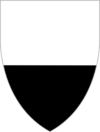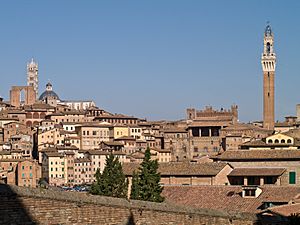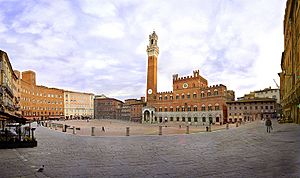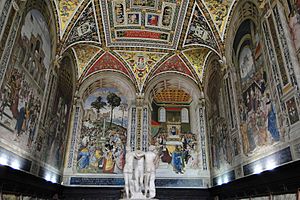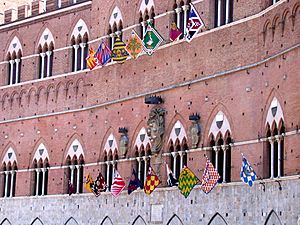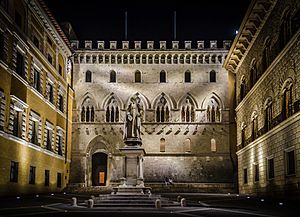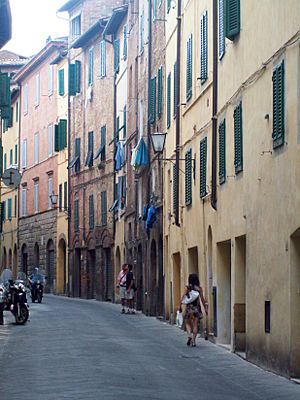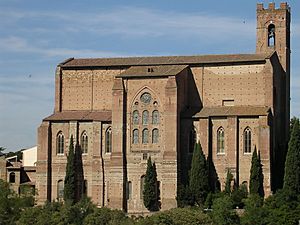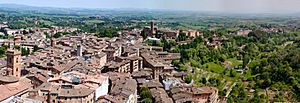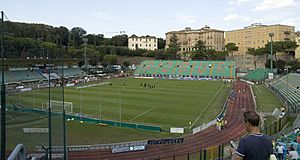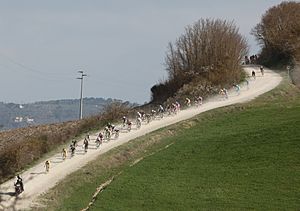Province of Siena facts for kids
Quick facts for kids
Siena
|
||
|---|---|---|
| Comune di Siena | ||
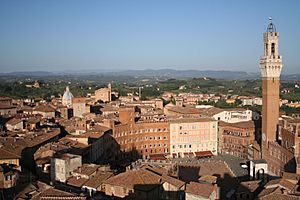
View of Piazza del Campo (Campo Square), the Mangia Tower (Torre del Mangia) and Santa Maria in Provenzano Church
|
||
|
||
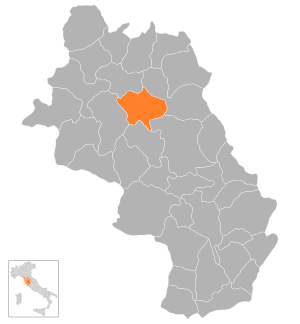 |
||
| Country | Italy | |
| Region | Tuscany | |
| Province | Siena (SI) | |
| Frazioni | Costalpino, Isola d'Arbia, Taverne d'Arbia, San Miniato, Vignano, Ruffolo | |
| Area | ||
| • Total | 118 km2 (46 sq mi) | |
| Elevation | 322 m (1,056 ft) | |
| Population
(31 December 2017)
|
||
| • Total | 53,901 | |
| • Density | 456.8/km2 (1,183/sq mi) | |
| Demonym(s) | Senese | |
| Time zone | UTC+1 (CET) | |
| • Summer (DST) | UTC+2 (CEST) | |
| Postal code |
53100, 53010
|
|
| Dialing code | 0577 | |
| Patron saint | St. Ansanus/ Ambrose of Siena |
|
| Saint day | 1 December/ 8 October |
|
| UNESCO World Heritage Site | ||
| Criteria | Cultural: (i)(ii)(iv) | |
| Inscription | 1995 (19th Session) | |
| Area | 170 ha (420 acres) | |
| Buffer zone | 9,907 ha (24,480 acres) | |
Siena is a historic city in the Tuscany region of Italy. It is the main city of the province of Siena.
The old part of Siena is so special that UNESCO has named it a World Heritage Site. This means it's a place of great importance to everyone in the world. Siena is very popular with tourists, with thousands visiting each year.
The city is famous for many things. People love its delicious food, amazing art, and interesting museums. Siena is also known for its medieval buildings. One of its biggest attractions is the Palio, a thrilling horse race held twice a year.
Contents
History of Siena
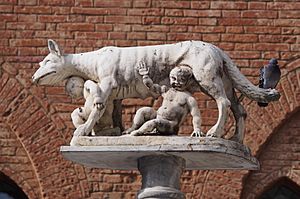
Siena, like other towns in Tuscany, was first settled by the Etruscans. This was around 900 to 400 BC. They were an advanced group of people. They used irrigation to make land farmable and built their towns on hills for protection.
Later, the Romans founded a town here called Saena Julia. This happened during the time of Emperor Augustus. Some experts believe that a Gaulish tribe called the Senones also controlled Siena for a while.
A local legend says that Siena was founded by Senius and Aschius. They were the sons of Remus, whose brother Romulus founded Rome. The story says that after Romulus killed their father, the brothers fled Rome. They took with them a statue of a she-wolf feeding two babies. This statue, known as the Capitoline Wolf, became a symbol for Siena. The legend also says they rode white and black horses. This led to the Balzana, Siena's coat of arms, which has a white band over a dark band.
Siena didn't do very well under Roman rule. It wasn't near any major trade routes. Christianity also didn't reach the city until the 4th century AD. Siena only began to prosper when the Lombards took over the area. The Lombards changed their trade routes to go through Siena. This made Siena an important trading post. Many pilgrims traveling to and from Rome also brought money to the city.
The oldest noble families in Siena trace their history back to 774. This was when the Lombards surrendered to Charlemagne. Many Frankish leaders came to Siena and married into the local noble families. They also built many abbeys in the area. Over time, the power of these feudal lords decreased. By 1115, the region broke into several independent areas. This led to the creation of the Republic of Siena.
The Republic of Siena lasted for over 400 years, until 1555. Before the terrible Black Death plague in 1348, Siena was a large city. About 50,000 people lived there.
In a war between 1551 and 1559, Siena was defeated. It lost to the Duchy of Florence, which was allied with Spain. After fighting for 18 months, Siena surrendered to Spain on April 17, 1555. This was the end of the Republic.
The new Spanish king, Felipe II, owed a lot of money to the Medici family. So, he gave Siena to the Grand Duchy of Tuscany. Siena remained part of Tuscany until Italy became one country in the 1800s.
Geography of Siena
Siena is in the middle of Tuscany, Italy. It's surrounded by beautiful hills and valleys. These include the Arbia river valley to the south and the Chianti hills to the northeast. The city itself sits about 322 meters (1,056 feet) above sea level.
Climate
Siena has a typical Mediterranean climate, but it's inland. This means it has warm, dry summers and mild, wet winters. The average rainfall is about 750 millimeters (30 inches) per year. Most rain falls in November, and July is the driest month. July is also the hottest month, with an average temperature of 22.2°C (72°F). January is the coldest.
Main Sights to See
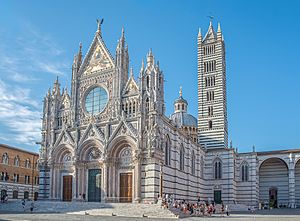
The Siena Cathedral (also called the Duomo) started being built in the 1100s. It's a fantastic example of Italian Romanesque and Gothic architecture. Its main front was finished in 1380. There were plans to make the church even bigger, possibly the largest in the world. However, wars and the Black Death meant they ran out of money. You can still see two walls from this unfinished part. If you climb an internal staircase, you get a great view of the city!
Inside the Cathedral, you'll find the Siena Cathedral Pulpit. This amazing 13th-century artwork was carved by Nicola Pisano. It has lion statues at its base and carvings showing Bible stories. The floor of the cathedral is made of beautiful inlaid marble mosaics. Many artists worked on it, and it's one of the most detailed in Italy. The Sacristy and Piccolomini library have well-preserved Renaissance paintings by famous artists like Ghirlandaio and Pinturicchio. Other artists like Donatello and Lorenzo Ghiberti also created sculptures here. The Museo dell'Opera del Duomo nearby has Duccio's famous Maestà painting.
The Piazza del Campo is Siena's main town square. It's shaped like a shell and is in front of the Palazzo Pubblico. This square is where the exciting Palio horse race takes place. The Palazzo Pubblico itself is a beautiful building. It holds an important art museum. Inside, you can see amazing paintings like Ambrogio Lorenzetti's Allegory and Effects of Good and Bad Government. There are also beautiful paintings by Simone Martini.
The Palazzo Salimbeni is in a square with the same name. This building was and still is the main office of the Monte dei Paschi di Siena. This is one of the oldest banks in the world that is still open today!
The Accademia Musicale Chigiana is Siena's music school. It is located in the beautiful Gothic Palazzo Chigi-Saracini.
Other important churches in Siena include:
- Basilica dell'Osservanza
- Santa Maria dei Servi
- San Domenico
- San Francesco
- Santo Spirito
- San Martino
- The Sanctuary of Santa Caterina. This includes the old house of St. Catherine of Siena. It has a special Crucifix from which the saint received her stigmata.
The historic Siena synagogue is also open for visitors.
Siena also has lovely gardens. The Orto Botanico dell'Università di Siena is a botanical garden run by the University of Siena.
The Medicean Fortress is home to the Enoteca Italiana. It also houses the Siena Jazz School, which offers courses and concerts.
Around Siena, there are many old noble villas. Some of them are believed to be designed by Baldassarre Peruzzi:
- Villa Chigi
- Castle of Belcaro
- Villa Celsa
- Villa Cetinale
- Villa Volte Alte
Culture of Siena
Siena has a unique culture that comes from medieval times. The city is divided into different neighborhoods called contrade. Each contrada has its own animal symbol or mascot. They also have their own borders and a strong sense of identity. The rivalries between these neighborhoods are most clear during the annual Palio horse race. There are 17 contrade in total, with names like Aquila (Eagle), Bruco (Caterpillar), and Lupa (She-wolf).
The Palio Horse Race
The Palio di Siena is a very old horse race. It takes place in the Piazza del Campo twice a year. The races are held on July 2nd and August 16th. Huge crowds come to watch this exciting event, and it's also shown on TV.
Ten of the seventeen Contrade (city neighborhoods) are chosen to compete. They race for a special trophy. This trophy is a painted banner, or Palio, which shows an image of the Blessed Virgin Mary.
Art in Siena
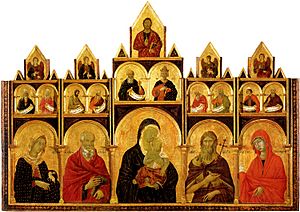
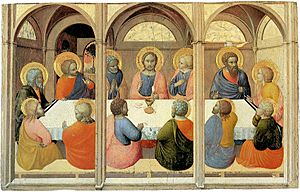
For centuries, Siena has been a center for arts and artists. The Sienese School of art includes famous painters like Duccio and his student Simone Martini. Other important artists were Pietro Lorenzetti and Martino di Bartolomeo. Many famous artworks from the Renaissance period are still in Siena's galleries and churches.
The Church of San Domenico has art by Guido da Siena from the mid-1200s. Duccio's Maestà painting was ordered by the city of Siena in 1308. This painting was very important because it helped change Italian painting. It moved away from the old, stiff style of Byzantine art towards showing reality more directly. Duccio's Madonna and Child with Saints painting is also in Siena. You can see it at the city's Pinacoteca Nazionale.
The Pinacoteca also has works by Domenico Beccafumi, Lorenzo Lotto, and Fra Bartolomeo.
Economy of Siena
Siena's main activities are tourism, services, farming, crafts, and light industry.
Agriculture
Farming is a very important industry in Siena. As of 2009, there were 919 farming companies in Siena. They used a total area of about 10.755 square kilometers (4.153 square miles) for farming. This is about one-third of the city's total area.
Industry and Manufacturing
Siena's industrial sector is not very large. However, some important manufacturing businesses have grown recently.
The confectionery industry is one of the most important traditional industries. This is because of Siena's many local sweet specialties. Some of the most famous are Panforte, which is like an old type of fruitcake. There are also Ricciarelli biscuits, made from almond paste. Another well-known sweet is Noto, made with honey, almonds, and pepper. These treats are made in bakeries all over the city.
The area has also seen growth in biotechnology. A company called Novartis Vaccines used to develop and produce vaccines here. In 2015, this research plant became part of Glaxo Smith Kline.
Services and Finance
In the service industry, the most important financial activity is the bank Monte dei Paschi di Siena. This bank is headquartered in Siena. It is the oldest bank in the world that has been open continuously since 1472.
The University of Siena and the local hospital are also very important. They employ thousands of people. They serve a much larger area than just the city itself. There are also many small businesses in the area. These businesses are active in trade and tourism.
In recent years, Siena has been fully connected with fiber optic cables. This means that almost every house in Siena has access to fast internet. This was part of a project to make Siena the first city in Italy with this kind of wiring.
Sports in Siena
Siena has a long history of sports. Basketball and football (soccer) are the most popular sports here. Other sports like rugby and athletics are also played.
Professional Sports Teams
The Associazione Calcio Siena (football club) was founded in 1904. It first reached Italy's top league, Serie A, in the 2003–04 season. It stayed there for nine seasons. The club faced financial problems in 2014. A new club, Società Sportiva Robur Siena, took its place. It had to start from a lower league, Serie D. Currently, it plays in the Lega Pro league. The team plays its home games at the Stadio Artemio Franchi.
Siena's main men's basketball team was called Mens Sana Basket. It was the oldest sports club in Siena. Mens Sana Basket played in Italy's highest league, Lega Basket Serie A. It won the national championship eight times, including seven times in a row (2007–13). The team played its home games at the PalaEstra indoor arena. Like the football team, this club also had financial issues in 2014. A new club, Mens Sana 1871, took its place. It currently plays in the Serie A2 league. Siena also helped host the EuroBasket 1979 basketball tournament.
Siena is the start and finish point for the Strade Bianche. This is a professional cycling race famous for its historic white gravel roads. These roads are called strade bianche or sterrati in Italian. More than 50 kilometers (31 miles) of the race are on these dirt roads. They twist through the hills and vineyards of the Chianti region. The race finishes in the Piazza del Campo. Riders have to climb a steep and narrow road called Via Santa Caterina to reach the finish line.
In 2015, the volleyball team Emma Villas moved to Siena. They were promoted to Serie A2 and wanted a bigger audience. They now play their home games at PalaEstra.
Amateur Sports
Siena also has several amateur basketball teams. These include the Associazione Sportiva Costone Basket and Virtus Siena.
There are also several women's university sports teams. These are organized under the CUS (Centro Universitario Sportivo). They include sports like fencing, volleyball, and rugby. There is also a basketball team made up only of students from the University of Siena.
Transport in Siena
The closest international airports to Siena are Peretola Airport in Florence and Galileo Galilei International Airport in Pisa. There are also two to three buses each day between Siena and Bologna Airport.
You can reach Siena by train from both Pisa and Florence. You will need to change trains at Empoli. The Siena railway station is at the bottom of a long hill outside the city walls. A series of escalators connects the train station to the old city on top of the hill.
Buses leave from Piazza Gramsci, which is inside the city walls. You can take direct buses to and from Florence (about a one-hour trip). There are also buses to Rome (three hours) and Milan (four and a half hours). Buses also connect Siena to many other towns in Tuscany and beyond.
Road Travel
By road, Siena is connected to Florence by a "superstrada." This is a type of toll-free highway called the Raccordo Autostradale RA03 – Siena-Firenze. On some road signs, this superstrada is shown as SI-FI. This refers to the province abbreviations. This four-lane road continues to the southeast. It makes it easier to drive towards Perugia and to Rome using the A1 highway.
Cars are mostly not allowed inside the city center. There are several large car parks just outside the city walls. The "La Fortezza" and "Il Campo" car parks are closest to the center. There are also free parking areas further out, near Porta Romana. Delivery vehicles are only allowed in the city during morning hours.
Twin Towns
Siena is twinned with these cities:
 Avignon, France
Avignon, France Concord, North Carolina, US, since 2016
Concord, North Carolina, US, since 2016 Weimar, Germany, since 1994
Weimar, Germany, since 1994 Wetzlar, Germany, since 1987
Wetzlar, Germany, since 1987
Image gallery
See also
 In Spanish: Provincia de Siena para niños
In Spanish: Provincia de Siena para niños


